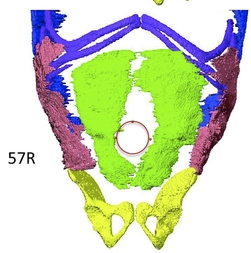季さんの論文がAnat Recに掲載されました。

胎児期初期の臍帯ヘルニアの還納と腹壁(腹直筋)の形成との関連性について検討しました。
- 成長とともに腹直筋の走行は、腹壁の外側部分から正中線領域にシフトした。
- 腹直筋の尾側部分はほとんど標本で菲薄であった.
- 腹直筋の長さ、腹囲は、胎児の成長と正の相関を示した。
- ダイナミックな腸管の再配置にもかかわらず、腹直筋、腹直筋間の距離、臍帯サイズはほとんど変化しない。
- 腹直筋を含む腹壁の形成は、臍帯体腔内または腹腔内の中腸 ヘルニアの段階とは無関係
Ji X, Ishikawa A, Nagata A, Yamada S, Imai H, Matsuda T, Takakuwa T, Relationship between rectal abdominis muscle position and physiological umbilical herniation and return: a morphological and morphometric study. Anat Rec 2020, 303, 12, 3044-3051. doi: 10.1002/ar.24486
受諾は1年前だったのですが、ようやくpublishされました。
Abstract
The herniation of the intestinal loop (IL) in the extraembryonic coelom and its return to abdominal cavity is in parallel with the formation of the rectal abdominis muscle (RAM). Using high-resolution magnetic resonance imaging data of human fetuses (n = 19, CRL22-69 mm; stored at Kyoto Collection), this study aimed to analyze the relationship between the development of RAM and phase of IL herniation. The RAM runs at the lateral part of the abdominal wall in the small samples in the herniation phase. The position was shifted to the midline area in the larger samples in the herniation phase. According to fetal growth, the caudal ends of the muscles extended along the umbilical ring towards the pubis, though the caudal part of the RAMs were thin and faint in most of the samples. Length measurements related with the growth of the abdominal wall including RAM and abdominal circumference showed positive correlation with fetal growth. On the contrary, diastasis of RAMs and the width and area of the umbilical ring were almost constant according to fetal growth. Such morphometric value showed no obvious changes regardless of the phases of herniation. The ratio of the width and diastasis of the RAMs to the circumference was decreased, indicating that the closure of the ventral body wall was influenced by growth differences. The present data indicate that the formation of the abdominal wall including RAM is independent of the phase of IL herniation, whether in the extraembryonic coelom or in the abdominal cavity.







